Related Research Articles
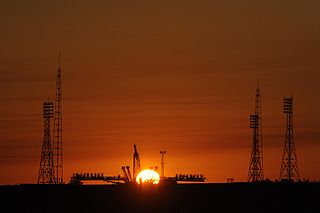
A spaceport or cosmodrome is a site for launching or receiving spacecraft, by analogy to a seaport for ships or an airport for aircraft. The word spaceport, and even more so cosmodrome, has traditionally been used for sites capable of launching spacecraft into orbit around Earth or on interplanetary trajectories. However, rocket launch sites for purely sub-orbital flights are sometimes called spaceports, as in recent years new and proposed sites for suborbital human flights have been frequently referred to or named "spaceports". Space stations and proposed future bases on the Moon are sometimes called spaceports, in particular if intended as a base for further journeys.

Vostok was a family of rockets derived from the Soviet R-7 Semyorka ICBM and was designed for the human spaceflight programme. This family of rockets launched the first artificial satellite and the first crewed spacecraft (Vostok) in human history. It was a subset of the R-7 family of rockets.
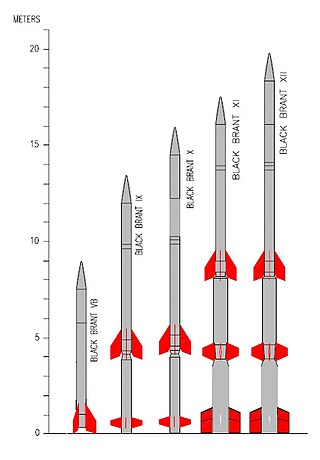
The Black Brant is a family of Canadian-designed sounding rockets originally built by Bristol Aerospace, since absorbed by Magellan Aerospace in Winnipeg, Manitoba. Over 800 Black Brants of various versions have been launched since they were first produced in 1961, and the type remains one of the most popular sounding rockets. They have been repeatedly used by the Canadian Space Agency and NASA.
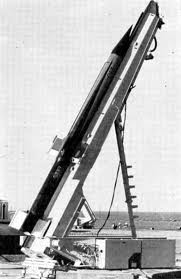
Centaure was a two-stage French sounding rocket consisting of a Venus first stage and a Belier second stage. It belongs to a family of solid-propellant rockets consisting of the Belier, Centaure, Dragon, Dauphin, and Eridan.
The INTA-255 was a Spanish sounding rocket developed by the Instituto Nacional de Tecnica Aerospacial.
Punta Lobos is a headland and was a launch site for sounding rockets in Peru at 12°30′S76°48′W. Between 1980 and 1990, various rockets of the type super Loki, Nike Orion, Taurus Orion and Taurus Tomahawk were launched there.
Astrobee is the designation of series of American sounding rockets with one to three stages.
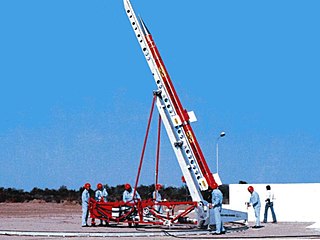
CELPA (El Chamical)(Centro de Experimentación y Lanzamiento de Proyectiles Autopropulsados) was a rocket launch site in Argentina, near El Chamical at 08°30′S66°19′W, in the La Rioja Province.
DGA Essais de missiles is a launch site for the test of military rockets and for launching sounding rockets in France. "DGA Essais de missiles" is situated between Biscarrosse and the Atlantic Ocean at 44°27′N1°15′W. "DGA Essais de missiles" went in service in 1967 as replacement for the former launch sites at CIEES, Hammaguir.

Lambda is the name of a series of Japanese carrier rockets. It consisted of the types Lambda 2, LSC-3, Lambda 3, Lambda 3H, Lambda 4S, Lambda 4SC, and Lambda 4T developed jointly by Institute of Industrial Science of the University of Tokyo, Institute of Space and Astronautical Science of the University of Tokyo, and Prince Motor Company, which merged with Nissan in 1966.
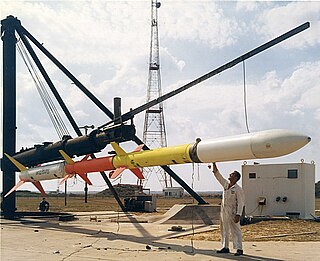
Javelin was the designation of an American sounding rocket. The four stage Javelin rocket had a payload of around 125 pounds, an apogee of 1100 kilometers, a liftoff thrust of 365 kilonewtons, a total mass of 3,385 kilograms (7,463 lb), and a core diameter of 580 millimeters (22.8 in). It was launched 82 times between 1959 and 1976.
Las Palmas is a rocket launch site in Argentina at 27.13°S 58.75°W used on November 12, 1966, for the launch of two Titus rockets for observing a solar eclipse.
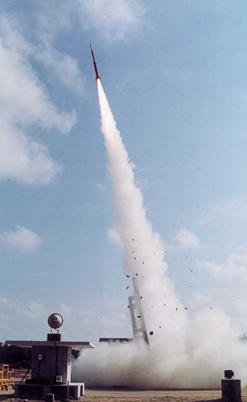
Thumba Equatorial Rocket Launching Station (TERLS) is an Indian rocket launching site established on 21 November 1963. Operated by the Indian Space Research Organisation (ISRO), it is located in Thumba, Thiruvananthapuram, which is near the southwestern tip of mainland India, very close to Earth's magnetic equator. It is currently used by ISRO for launching sounding rockets.

This comparison of orbital launch systems lists the attributes of all individual rocket configurations designed to reach orbit. A first list contains rockets that are operational or in development as of 2023; a second list includes all upcoming rockets and a third list includes all retired rockets. For the simple list of all conventional launcher families, see: Comparison of orbital launchers families. For the list of predominantly solid-fueled orbital launch systems, see: Comparison of solid-fueled orbital launch systems.

Maxus is a sounding rocket that are used in the MAXUS microgravity rocket programme, a joint venture between Swedish Space Corporation and EADS Astrium Space Transportation used by ESA. It is launched from Esrange Space Center in Sweden and provides access to microgravity for up to 14 minutes.
The Universal Rocket or UR family of missiles and carrier rockets is a Russian, previously Soviet rocket family. Intended to allow the same technology to be used in all Soviet rockets, the UR is produced by the Khrunichev State Research and Production Space Center. Several variants were originally planned, of which only three flew, and only two of which entered service. In addition, the cancelled UR-500 ICBM formed the basis for the Proton carrier rocket.

Rohini is a series of sounding rockets developed by the Indian Space Research Organisation (ISRO) for meteorological and atmospheric study. These sounding rockets are capable of carrying payloads of 2 to 200 kilograms between altitudes of 100 to 500 kilometres. The ISRO currently uses RH-200, RH-300,Mk-II, RH-560 Mk-II and RH-560 Mk-III rockets, which are launched from the Thumba Equatorial Rocket Launching Station (TERLS) in Thumba and the Satish Dhawan Space Centre in Sriharikota.
CELPA (Mar Chiquita) also known as CELPA Atlántico (Centro de Experimentación y Lanzamiento de Proyectiles Autopropulsados) was a rocket launch site in Mar Chiquita, Argentina, north of Mar del Plata.

A small-lift launch vehicle is a rocket orbital launch vehicle that is capable of lifting 2,000 kg (4,400 lb) or less or under 5,000 kilograms (11,000 lb) of payload into low Earth orbit (LEO). The next larger category consists of medium-lift launch vehicles.
References
- ↑ "Chilca". www.astronautix.com. Retrieved 2024-04-14.
- ↑ "Chilca PLOB". www.astronautix.com. Retrieved 2024-04-14.